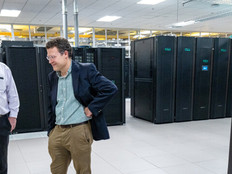Not Too Big, Not Too Small
The idea behind netbooks pleases the techie in me.
When I saw the first 7-inch model of the Asus Eee PC, I thought it was a great concept, but the keyboard was too small for my hands. Asus has since released the 1000 series, which includes 10-inch screens, larger keyboards and more processing power. They’ve got the right size this time.
Advantages
When unpacking the Eee, I was impressed with the way Asus packaged the little netbook. It might seem strange to mention packaging, but anyone who has removed a computer from a crushed box will understand.
Inside the box was the usual “Getting Started” poster and a power brick. A microfiber cloth for cleaning the shell and the screen is a nice addition and would be a welcome extra with all new netbooks. The power connector is on the right side of the machine, which also includes three USB ports, a VGA connector, an Ethernet jack and an SD card reader.
The model that I evaluated came equipped with a 1.6-gigahertz Intel Atom processor, 1 gigabyte of RAM, a 40GB solid-state hard drive and Linux (rather than Microsoft Windows). The Linux system boots fast, and everything I launched ran fast as well. But any program that requires substantial computing power will suffer because of the processor. For example, I loaded Windows XP during testing and noticed it took nearly 90 minutes to load Service Pack 3 on top of the WinXP SP2 install. I didn’t seem to run into these issues while using Linux, and I suspect that it has to do with its specially tuned version of Xandros Linux.
The Eee came bundled with several open-source titles, as well as Sun Microsystems StarOffice. I ran into some issues with StarOffice and ended up replacing it with a more current version of OpenOffice, which made the netbook more reliable.
Why It Works for IT
I normally take a notebook to meetings so I can access my calendar, as well as files, the web and e-mail. I decided to tote along the Eee rather than my regular system. Technology personnel will appreciate the built-in Remote Desktop program that allows access to Windows servers wherever you can find a connection.
When booting, the Eee presents a desktop with all icons arranged in folders — a bit different from the familiar launch or Start menu. I found the desktop easy to navigate for preloaded programs but could not figure out how to add programs to the screen. This was frustrating, but I quickly found some programs on the web to run the K Desktop Environment instead of the Eee desktop, turning this into a quite powerful netbook. Battery life is also impressive at up to six hours, and standby/hibernate mode extends life significantly.
Disadvantages
Although I was pleased with the customized Xandros Linux, it needs some tweaks to accommodate a power user.
The keyboard was far more usable than that on the 7-inch Eee, but I still ran into issues with the right-hand Shift key because of its placement. It took a conscious effort to hit that key rather than the up arrow — many times I found myself typing one line higher than where I wanted to be.







